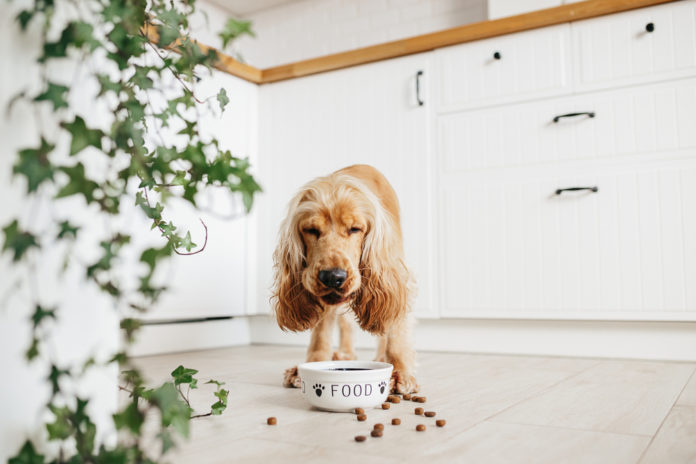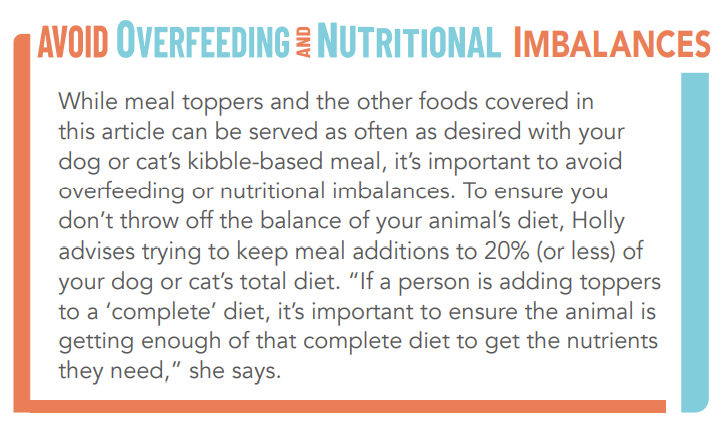Enhancing your pet’s kibble-based diet

While many pet kibbles are improving in quality, it’s never a bad idea to add some extra nutritional value and variety to these foods. If your dog or cat eats a kibble-based diet, here are some foods and meal toppers that will enhance its nutritional impact.
Not long ago, most kibble-based diets were regarded as the least favorable way to feed your dog or cat. They were lacking in whole meat ingredients, and were full of grains, empty fillers, preservatives, and other less-than-ideal ingredients. The cheaper brands haven’t changed much, but many manufacturers are now taking steps to formulate healthier kibble diets that better meet feline and canine nutritional needs. Whichever kibble-based diet your dog or cat may eat, it never hurts to supplement it with fresh foods or meal toppers. Not only does this add more nutritional value, but it also gives your animal some extra flavor and variety. Here are some ideas to get you started.
Bone broth
Many cats and dogs, especially those eating dry foods, don’t drink enough water, so adding hydration to their diets is essential. Bone broth is easy to add at mealtime, and is a good source of protein, the amino acid glycine, and collagen.
Coconut oil
This oil can be used both topically and orally to keep your animal’s coat shiny. As an added bonus, it can reduce inflammation in a cat’s digestive tract. Lauric acid, a saturated fat found in coconut oil, can soothe inflammation all over the body.
Natural probiotics
Dairy products such as kefir, yogurt and buttermilk, as well as fermented vegetables including sauerkraut, ginger carrots, kimchi and beets, can aid in digestion and help ease the symptoms of chronic diarrhea in cats and dogs.

“Digestive issues are very prevalent in modern dogs,” say certified pet food nutrition specialist, Holly Montgomery. “They can be due to stress, environmental toxins, antibiotic treatment, medications and more. In fact, it’s at the point now where I recommend probiotics for every dog.”
Fresh fruits and vegetables
Dogs may enjoy eating kale, spinach, carrots, green beans, broccoli, etc. with their kibble. For fruits, consider pieces of apple (minus the seeds and core), blueberries, cranberries, cantaloupe and bananas. Some cats like carrots, peas, broccoli florets, green beans, zucchini, spinach, and winter squash. Be sure to avoid fruits and veggies that are toxic to animals – prime examples are onions, grapes and raisins.
Hint: Vegetables should be lightly steamed or pureed to enhance digestibility and nutrient absorption.
Goat’s milk
Raw goat’s milk can be beneficial for both cats and dogs. It may be served with the kibble or on its own, and it also freezes well for treats. Goat’s milk can be a good alternative for animals with sensitivity to bovine milk.
Pumpkin Puree
High in soluble fiber, pumpkin puree is a popular go-to treatment for cats and dogs experiencing diarrhea or constipation. Adding a bit to their meals can help them have regular bowel movements. It can also help dogs and cats with indigestion or upset stomachs.
Hint: Cooked sweet potatoes, without skins, have similar benefits to pumpkin.
Sardines
These tiny fish are a great source of taurine and Omega-3 fatty acids. Taurine is essential for heart health. Try replacing a portion of your dog or cat’s kibble meal with a few sardines, two to three times weekly.
“Inflammation of skin or joints could benefit from the addition of Omega-3 fatty acids,” adds certified pet food nutrition specialist, Holly Montgomery. “Most kibble diets are very high in Omega-6s, and since Omega-3s and 6s need to be in balance, most animals need Omega-3s added to their diet. I personally like sardines because they are small, short-lived fish that don’t feed on other fish. With the state of our waters, it’s best to choose fish that have a lower likelihood of accumulating toxins.”
Hint: You can also alternate eggs with sardines.
Raw or cooked meat
Adding a bit of raw or cooked meat or poultry to your dog or cat’s dry meal will really add a boost of nutrition and taste. Meat contains iron, zinc, copper, manganese and selenium. It is rich in thiamine, riboflavin, niacin, B6, and B12.
Adding glucosamine- and chondroitin-rich toppers like chicken or duck feet can help with joint support, adds Holly.




